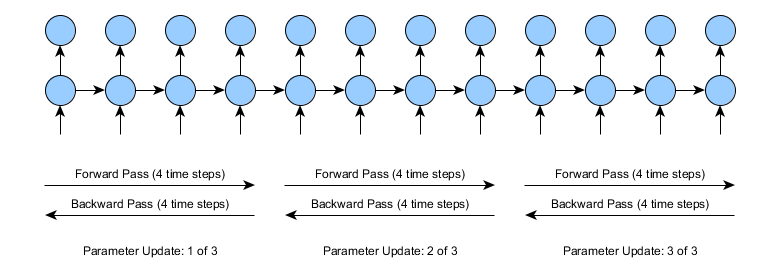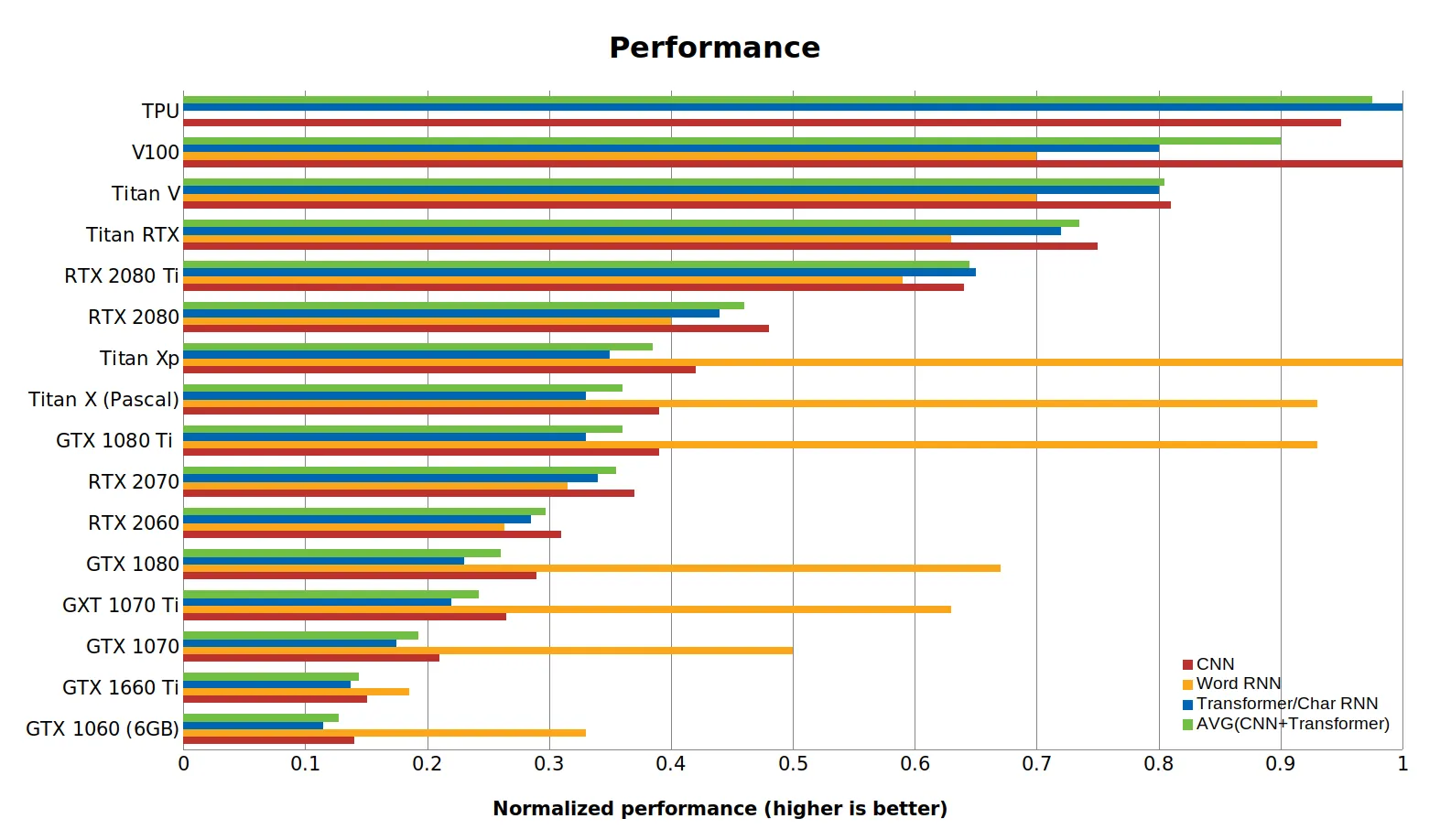5.3 Truncated BPTT
Contents
5.3 Truncated BPTT¶
When the sequences are very long (thousands of points), the network training can be very slow and the memory requirements increase. The truncated BPTT is an alternative similar to mini-batch training in Dense Networks, even though in RNN the batch parameter can also be used.
!wget -nc --no-cache -O init.py -q https://raw.githubusercontent.com/rramosp/2021.deeplearning/main/content/init.py
import init; init.init(force_download=False);
import sys
if 'google.colab' in sys.modules:
print ("setting tensorflow version in colab")
%tensorflow_version 2.x
import tensorflow as tf
tf.__version__
from IPython.display import Image
Image(filename='local/imgs/rnn_tbptt_2.png', width=1200)
#

The TBPTT can be implemented by setting up the data appropriately. Let’s remember that for recurrent neural networks, data must have the format [n_samples,n_times,n_features], so if you want to use Truncated BPTT you just have to split the sequences into more n_samples of less n_times.
BUT, Is it possible that the LSTM may find dependencies between the sequences?¶
No it’s not possible unless you go for the stateful LSTM.
So the use of Truncated BPTT requires to set up the Stateful mode.
Example¶
Extracted from: http://philipperemy.github.io/keras-stateful-lstm/
Let’s see a problem of classifying sequences. The data matrix \(X\) is made exclusively of zeros except in the first column where exactly half of the values are 1.
import numpy as np
from numpy.random import choice
N_train = 1000
X_train = np.zeros((N_train,20))
one_indexes = choice(a=N_train, size=int(N_train / 2), replace=False)
X_train[one_indexes, 0] = 1 # very long term memory.
#--------------------------------
N_test = 200
X_test = np.zeros((N_test,20))
one_indexes = choice(a=N_test, size=int(N_test / 2), replace=False)
X_test[one_indexes, 0] = 1 # very long term memory.
print(X_train[:10,:5])
print(X_test[:10,:5])
[[1. 0. 0. 0. 0.]
[0. 0. 0. 0. 0.]
[0. 0. 0. 0. 0.]
[1. 0. 0. 0. 0.]
[1. 0. 0. 0. 0.]
[0. 0. 0. 0. 0.]
[0. 0. 0. 0. 0.]
[0. 0. 0. 0. 0.]
[1. 0. 0. 0. 0.]
[1. 0. 0. 0. 0.]]
[[1. 0. 0. 0. 0.]
[1. 0. 0. 0. 0.]
[1. 0. 0. 0. 0.]
[1. 0. 0. 0. 0.]
[1. 0. 0. 0. 0.]
[0. 0. 0. 0. 0.]
[0. 0. 0. 0. 0.]
[1. 0. 0. 0. 0.]
[1. 0. 0. 0. 0.]
[0. 0. 0. 0. 0.]]
print(X_train.shape)
(1000, 20)
def prepare_sequences(x_train, y_train, window_length, increment):
windows = []
windows_y = []
for i, sequence in enumerate(x_train):
len_seq = len(sequence)
for window_start in range(0, len_seq - window_length + 1, increment):
window_end = window_start + window_length
window = sequence[window_start:window_end]
windows.append(window)
windows_y.append(y_train[i])
return np.array(windows), np.array(windows_y)
#Split the sequences into two sequences of length 10
window_length = 10
x_train, y_train = prepare_sequences(X_train, X_train[:,0], window_length,window_length)
x_test, y_test = prepare_sequences(X_test, X_test[:,0], window_length,window_length)
x_train = x_train.reshape(x_train.shape[0],x_train.shape[1],1)
x_test = x_test.reshape(x_test.shape[0],x_test.shape[1],1)
y_train = y_train.reshape(y_train.shape[0],1)
y_test = y_test.reshape(y_test.shape[0],1)
print(x_train.shape)
print(y_train.shape)
print(x_test.shape)
print(y_test.shape)
(2000, 10, 1)
(2000, 1)
(400, 10, 1)
(400, 1)
Every sequence was split into 2 subsequences
print(x_train[:4,:])
print(y_train[:4,:])
[[[1.]
[0.]
[0.]
[0.]
[0.]
[0.]
[0.]
[0.]
[0.]
[0.]]
[[0.]
[0.]
[0.]
[0.]
[0.]
[0.]
[0.]
[0.]
[0.]
[0.]]
[[0.]
[0.]
[0.]
[0.]
[0.]
[0.]
[0.]
[0.]
[0.]
[0.]]
[[0.]
[0.]
[0.]
[0.]
[0.]
[0.]
[0.]
[0.]
[0.]
[0.]]]
[[1.]
[1.]
[0.]
[0.]]
Let’s train a regular LSTM network¶
from tensorflow.keras.layers import LSTM, Dense
from tensorflow.keras.models import Sequential
#Para resolver problema de compatibilidad tf 2.4 con algunas GPUs
from tensorflow.compat.v1 import ConfigProto
from tensorflow.compat.v1 import InteractiveSession
config = ConfigProto()
config.gpu_options.allow_growth = True
session = InteractiveSession(config=config)
Using the original sequences:¶
print('Building STATELESS model...')
max_len = 10
batch_size = 11
model = Sequential()
model.add(LSTM(10, input_shape=(20, 1), return_sequences=False, stateful=False))
model.add(Dense(1, activation='sigmoid'))
model.compile(loss='binary_crossentropy', optimizer='adam', metrics=['accuracy'])
model.fit(X_train.reshape(1000,20,1), X_train[:,0].reshape(1000,1), batch_size=batch_size, epochs=5,
validation_data=(X_test.reshape(200,20,1), X_test[:,0].reshape(200,1)), shuffle=False)
score, acc = model.evaluate(X_test.reshape(200,20,1),X_test[:,0].reshape(200,1), batch_size=batch_size, verbose=0)
Building STATELESS model...
Epoch 1/5
91/91 [==============================] - 3s 6ms/step - loss: 0.6856 - accuracy: 0.5882 - val_loss: 0.3346 - val_accuracy: 1.0000
Epoch 2/5
91/91 [==============================] - 0s 2ms/step - loss: 0.2117 - accuracy: 1.0000 - val_loss: 0.0778 - val_accuracy: 1.0000
Epoch 3/5
91/91 [==============================] - 0s 2ms/step - loss: 0.0652 - accuracy: 1.0000 - val_loss: 0.0351 - val_accuracy: 1.0000
Epoch 4/5
91/91 [==============================] - 0s 2ms/step - loss: 0.0302 - accuracy: 1.0000 - val_loss: 0.0204 - val_accuracy: 1.0000
Epoch 5/5
91/91 [==============================] - 0s 2ms/step - loss: 0.0185 - accuracy: 1.0000 - val_loss: 0.0141 - val_accuracy: 1.0000
acc
1.0
Using the splitted sequences:¶
print('Building STATELESS model...')
max_len = 10
batch_size = 2
model = Sequential()
model.add(LSTM(10, input_shape=(max_len, 1), return_sequences=False, stateful=False))
model.add(Dense(1, activation='sigmoid'))
model.compile(loss='binary_crossentropy', optimizer='adam', metrics=['accuracy'])
model.fit(x_train, y_train, batch_size=batch_size, epochs=15,
validation_data=(x_test, y_test), shuffle=False)
score, acc = model.evaluate(x_test, y_test, batch_size=batch_size, verbose=0)
Building STATELESS model...
Epoch 1/15
1000/1000 [==============================] - 2s 2ms/step - loss: 0.5768 - accuracy: 0.7036 - val_loss: 0.4794 - val_accuracy: 0.7500
Epoch 2/15
1000/1000 [==============================] - 2s 2ms/step - loss: 0.4783 - accuracy: 0.7574 - val_loss: 0.4785 - val_accuracy: 0.7500
Epoch 3/15
1000/1000 [==============================] - 2s 2ms/step - loss: 0.4774 - accuracy: 0.7574 - val_loss: 0.4782 - val_accuracy: 0.7500
Epoch 4/15
1000/1000 [==============================] - 2s 2ms/step - loss: 0.4771 - accuracy: 0.7574 - val_loss: 0.4780 - val_accuracy: 0.7500
Epoch 5/15
1000/1000 [==============================] - 2s 2ms/step - loss: 0.4769 - accuracy: 0.7574 - val_loss: 0.4779 - val_accuracy: 0.7500
Epoch 6/15
1000/1000 [==============================] - 2s 2ms/step - loss: 0.4767 - accuracy: 0.7574 - val_loss: 0.4779 - val_accuracy: 0.7500
Epoch 7/15
1000/1000 [==============================] - 2s 2ms/step - loss: 0.4766 - accuracy: 0.7574 - val_loss: 0.4778 - val_accuracy: 0.7500
Epoch 8/15
1000/1000 [==============================] - 2s 2ms/step - loss: 0.4765 - accuracy: 0.7574 - val_loss: 0.4778 - val_accuracy: 0.7500
Epoch 9/15
1000/1000 [==============================] - 2s 2ms/step - loss: 0.4765 - accuracy: 0.7574 - val_loss: 0.4777 - val_accuracy: 0.7500
Epoch 10/15
1000/1000 [==============================] - 2s 2ms/step - loss: 0.4764 - accuracy: 0.7574 - val_loss: 0.4777 - val_accuracy: 0.7500
Epoch 11/15
1000/1000 [==============================] - 2s 2ms/step - loss: 0.4764 - accuracy: 0.7574 - val_loss: 0.4777 - val_accuracy: 0.7500
Epoch 12/15
1000/1000 [==============================] - 2s 2ms/step - loss: 0.4763 - accuracy: 0.7574 - val_loss: 0.4777 - val_accuracy: 0.7500
Epoch 13/15
1000/1000 [==============================] - 2s 2ms/step - loss: 0.4763 - accuracy: 0.7574 - val_loss: 0.4776 - val_accuracy: 0.7500
Epoch 14/15
1000/1000 [==============================] - 2s 2ms/step - loss: 0.4762 - accuracy: 0.7574 - val_loss: 0.4776 - val_accuracy: 0.7500
Epoch 15/15
1000/1000 [==============================] - 2s 2ms/step - loss: 0.4762 - accuracy: 0.7574 - val_loss: 0.4776 - val_accuracy: 0.7500
acc
0.75
The sequences composed of 0s are correctly classified. The subsequences starting with 1 are correctly classified, but the sebsequences of class 1 starting with 0, are wrong classified. Those are the 25% of the sequences.
What happened?¶
The long range memory required to classify the sequences correctly has been lost because of the sequences’ partition.
STATEFUL Model¶
print('Build STATEFUL model...')
max_len = 10
n_partitions = 2
batch = 1
model = Sequential()
model.add(LSTM(10, batch_input_shape=(batch, max_len, 1), return_sequences=False, stateful=True))
model.add(Dense(1, activation='sigmoid'))
model.compile(loss='binary_crossentropy', optimizer='adam', metrics=['accuracy'])
Build STATEFUL model...
print('Train...')
for epoch in range(5):
mean_tr_acc = []
mean_tr_loss = []
for i in range(0,x_train.shape[0],n_partitions):
#print(i)
for j in range(n_partitions):
#print(j)
tr_loss, tr_acc = model.train_on_batch(x_train[i+j,:,:].reshape(1,max_len,1), y_train[i+j,:].reshape(1,1))
mean_tr_acc.append(tr_acc)
mean_tr_loss.append(tr_loss)
model.reset_states()
print('accuracy training = {}'.format(np.mean(mean_tr_acc)))
print('loss training = {}'.format(np.mean(mean_tr_loss)))
print('___________________________________')
mean_te_acc = []
mean_te_loss = []
for i in range(0,x_test.shape[0],n_partitions):
for j in range(n_partitions):
te_loss, te_acc = model.test_on_batch(x_test[i+j,:,:].reshape(1,max_len,1), y_test[i+j,:].reshape(1,1))
mean_te_acc.append(te_acc)
mean_te_loss.append(te_loss)
model.reset_states()
print('accuracy testing = {}'.format(np.mean(mean_te_acc)))
print('loss testing = {}'.format(np.mean(mean_te_loss)))
print('___________________________________')
Train...
accuracy training = 0.97
loss training = 0.0724665543687297
___________________________________
accuracy testing = 1.0
loss testing = 0.0010425312793813646
___________________________________
accuracy training = 1.0
loss training = 0.0005047061592849786
___________________________________
accuracy testing = 1.0
loss testing = 0.00022369572980096564
___________________________________
accuracy training = 1.0
loss training = 0.00012951270282610493
___________________________________
accuracy testing = 1.0
loss testing = 6.860588746349094e-05
___________________________________
accuracy training = 1.0
loss training = 4.184540016831306e-05
___________________________________
accuracy testing = 1.0
loss testing = 2.338519880140666e-05
___________________________________
accuracy training = 1.0
loss training = 1.4540311468635991e-05
___________________________________
accuracy testing = 1.0
loss testing = 8.292114785035665e-06
___________________________________
The code was a bit more difficult to write because we have to manually call model.reset_states() at each new sequence processed. Another method to do that is to write a callback that reset the states at each sequence like this:
from tensorflow.keras.callbacks import Callback
n_partitions = 2
class ResetStatesCallback(Callback):
def __init__(self):
self.counter = 0
def on_batch_begin(self, batch, logs={}):
if self.counter % n_partitions == 0:
self.model.reset_states()
self.counter += 1
model = Sequential()
model.add(LSTM(10, batch_input_shape=(batch, max_len, 1), return_sequences=False, stateful=True))
model.add(Dense(1, activation='sigmoid'))
model.compile(loss='binary_crossentropy', optimizer='adam', metrics=['accuracy'])
model.fit(x_train, y_train, epochs=5, callbacks=[ResetStatesCallback()], batch_size=1, shuffle=False)
Train on 2000 samples
Epoch 1/5
2000/2000 [==============================] - 11s 5ms/sample - loss: 0.0740 - accuracy: 0.9625
Epoch 2/5
2000/2000 [==============================] - 10s 5ms/sample - loss: 4.8555e-04 - accuracy: 1.0000
Epoch 3/5
2000/2000 [==============================] - 12s 6ms/sample - loss: 1.2338e-04 - accuracy: 1.0000
Epoch 4/5
2000/2000 [==============================] - 10s 5ms/sample - loss: 3.9900e-05 - accuracy: 1.0000
Epoch 5/5
2000/2000 [==============================] - 8s 4ms/sample - loss: 1.3916e-05 - accuracy: 1.0000
<tensorflow.python.keras.callbacks.History at 0x7f82dc08b850>
When the dataset for validation have a different batchsize, the best way to solve it, is to create a new model with the new batchsize and transfer to it the weights of the trained model.
*Example: The following code does not have relation with the previous examples!
# configure network
n_batch = 3
n_epoch = 1000
n_neurons = 10
# design network
model = Sequential()
model.add(LSTM(n_neurons, batch_input_shape=(n_batch, X.shape[1], X.shape[2]), stateful=True))
model.add(Dense(1))
model.compile(loss='mean_squared_error', optimizer='adam')
# fit network
for i in range(n_epoch):
model.fit(X, y, epochs=1, batch_size=n_batch, verbose=1, shuffle=False)
model.reset_states()
# re-define the batch size
n_batch = 1
# re-define model
new_model = Sequential()
new_model.add(LSTM(n_neurons, batch_input_shape=(n_batch, X.shape[1], X.shape[2]), stateful=True))
new_model.add(Dense(1))
# copy weights
old_weights = model.get_weights()
new_model.set_weights(old_weights)
# compile model
new_model.compile(loss='mean_squared_error', optimizer='adam')
Discussion about GPU performance for Recurrent Networks¶
from IPython.display import Image
Image(filename='local/imgs/performance_RTX.png', width=1200)


